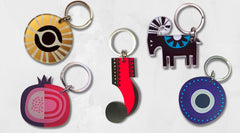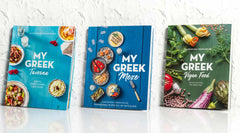Leather Journals From Greece

Leather journals are a great gift for pen and paper enthusiasts! Certainly, a trusted companion that helps you be "analog" in a digital world.
Above all, leather notebooks can help you stay organized.
They can be the one tool your creativity needs and sometimes can give you a therapeutic escape from everyday problems.
Start writing down your thoughts and feelings about your personal experiences, it really helps.
Check out our favorite goat leather journals, all made from byproducts of Cretan goats and are naturally tanned.
Most importantly, these journals are handmade and decorated on both sides with themes from ancient Greek art, bound with waxed thread.
These leather journals are more than a Greek souvenir:
The Golden Ratio Leather Journal

This leather journal depicts a composition of ancient Greek Architecture and geometrical lines based on the concept of golden ratio, the magical number φ=1.61803398875.
The analogies specific of the famous Parthenon, the temple of Goddess Athena in Athens are calculated and designed, based on the golden rule.
A whole philosophy in mathematics and aesthetics is based on this concept and it makes a great gift for philosophy lovers.

The Minoan Octopus Leather Notebook

The octopus motif found in many Minoan (Crete) vases and vessels suggests that Minoan culture worshiped the octopus. Minoan culture flourished from 2700 BC -1500 BC. Those vessels are a timeless reminder of man's capacity to create.
We don't know much about specifics of this culture and the artifacts from that age have been subject to much conjecture and speculation. The mystery continuous.
This journal depicts such a Minoan octopus motif.

Aphrodite And Diadumenos: The Two Greek Beauties

A journal with Aphrodite of Milos in the one side and Diadumenos on the other.
Both figures stand in contrapposto, name used in visual arts to describe a human figure standing with most of its weight on one foot so that its shoulders and arms twist off-axis from the hips and legs.
The balanced, harmonious pose suggests a calm and relaxed state of mind.
Firstly, Aphrodite of Milos (Venus de Milo) is one of the most famous works of ancient Greek sculptures, created between 130-100BC. Archaeologists suggest that it is dedicated to the Greek goddess of love and beauty (Aphrodite) and is now attributed to be a work of Alexandros of Antioch (some think that it could be a work of the sculptor Praxiteles).
Secondly, the Diadumenos is the winner of an athletic contest. One of the most famous figural types of the sculptor Polyclitus, presents a strictly idealized representation of a young male athlete in a convincingly naturalistic manner.

Geometric Art Leather Journal

Geometric art in Greece is characterized largely by geometric elements and forms in vase painting (end of the Greek Dark Ages, circa 900 BC – 700 BC).
Above all, for the first time, human figures appear on ceramics.
In addition, waterfowl and animals make their timid appearance in a large variety of geometric shapes. The first narrative and mythological scenes belong to this era.
Iliad and Odyssey were written in the late Geometric Period.
In this leather journal we see a scene with a chariot from the Iliad.

The Minotaur And Labyrinth

Certainly, Minotaur is one of the most famous Greek mythology beasts. Half man and half bull, the beast lived in the Labyrinth, designed by Daedalus.
Basically, the Minotaur as a symbol represents the primal fear of the unknown. In particular, Minotaur is fierce and immensely strong.
In the same way, the Labyrinth represents a journey to our own center and back again out into the world.
This journal depicts both these symbols of Greek mythology.

In conclusion, feel free to read more about the artists behind these leather creations.



















